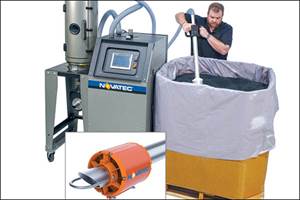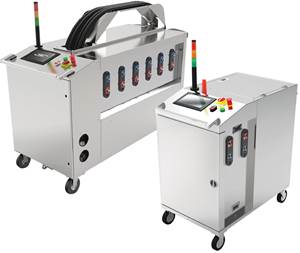Six-Axis Robots: Where They Fit in Injection Molding
Injection molded parts are typically demolded with simple pick-and-place automation—a top-mounted, gantry-style (also called Cartesian, linear, or traversing) three-axis robot.
Injection molded parts are typically demolded with simple pick-and-place automation—a top-mounted, gantry-style (also called Cartesian, linear, or traversing) three-axis robot. However, molders nowadays are looking for automated solutions to more complex tasks such as demolding complex shapes and handling upstream or downstream operations. “Demand is growing for the ability to orient the part,” says Joseph Portelli, program manager for plastics industries at Fanuc Robotics.
Some parts must be turned in the mold to ease removal when they have a difficult ejection angle or must pass under or over obstacles such as tiebars and mold slides, explains Dirk Schroeder, general manager of Remak Maschinenbau in Germany. There is also growing need for automation of insert loading and post-mold downstream operations. At the same time, many molders are faced with shorter runs and want their automation flexible enough for quick retasking. All of these are good reasons to consider articulated, or jointed-arm, six-axis robots.
“Articulated-arm robots are giving molders an opportunity to move away from ‘hard’ automation,in which a fixture would be built for a specific part,” says Slawomir Smolec, manager of robot automation for ABB. “Hard automation becomes expensive because it is designed for just one part, so when that job goes away the automation becomes obsolete. The shorter the product life cycles and the larger the variety of parts, the more expensive it gets.” Not so with a reprogrammable articulated robot. “This will give some molders the opportunity to bring downstream operations into the molding room,” adds Smolec. A more sophisticated robot could perform value-added functions—like part inspection, degating, grinding, gluing, welding, printing, labeling, and packaging—right at the press. Depending on the degree of complexity and space restraints, such tasks could present difficulties for a linear robot.
“Assuming the cycle time is long enough, six-axis robots can perform multiple tasks, which suits them to applications like high-cavitation insert molding,” says Jim Healy, v.p. of automation for Conair. “The articulated robot can build an array of inserts, pick them up, remove finished parts from the mold, place the inserts for the next cycle, degate the molded parts, and position them for automated inspection and packaging. Such a complicated sequence of operations would be very difficult, if not impossible, for a linear robot to achieve. When one six-axis robot can perform all these functions before, during, and after demolding parts, it can really add value to the process.”
In the past, molders may have been reluctant to consider six-axis robots because of their higher cost. But that has changed as cost-cutting initiatives throughout the robot industry have made these high-end models more affordable. “I have seen a 15% to 20% reduction in price for a six-axis robot in the past four or five years,” says Mauro Apostoli, automation product manager for AEC Inc. His firm and several other makers of three-axis linear robots have teamed up with suppliers of six-axis, jointed-arm robots to offer molders more complete automation solutions. This “system integration” approach to six-axis robots has also been followed by AEC’s sister company, Sterltech Robotics, as well as Automated Assemblies, Conair, Geiger, Husky, Krauss-Maffei, Remak, Ventax, and Yushin. System integrators will buy a six-axis robot then add the programming interface and safety and other peripheral equipment.
Meanwhile, six-axis-robot manufacturers are introducing new models designed specifically for plastics molding. Six-axis suppliers such as ABB, Adept, Fanuc Robotics, Kawasaki, Kuka, Motoman, Reis, and Staubli are complementing their floor-mounted units with platen-mounted versions and even “hybrid” gantry or beam-mounted designs, which can address space limitations beside a press or above it. Suppliers add that the greater complexity of programming a six-axis robot, previously a daunting task for a molder, is being addressed with more user-friendly controls.
Conair’s Healy says, “We have done an application with a Fanuc robot in a pick-and-place operation where instead of a Fanuc controller, we used our own linear-robot PLC to carry out programming and control of the robot. That simplified the operation.”
“There has been tremendous growth in cell-type automation systems that incorporate a linear robot for part takeout, which then hands the part to an articulated robot for downstream operations,” says John Mallon, president of Yushin America. His company, which manufactures linear robots, is a systems integrator for Motoman. David Preusse, president of Wittmann Automation, agrees that it is “not uncommon” today to see linear and articulated robots working hand in hand.
At the same time, several suppliers of linear robots have developed optional servo-wrist motions for their robots that bring five- or six-axis capability to Cartesian models. “Sometimes a molder only requires one or two added axes of motion,” says Preusse. We can provide that with a traversing robot without the expense of going to a full articulated robot.” Conair says it can provide up to eight axes of motion by pairing two linear robots on a single beam, each with servo wrist motion. Although wrist actions raise the price of a linear robot, it still costs less than an articulated type.
However, adding wrist motions cannot erase one difference between linear and articulated robots—their very different work envelopes. Unlike a linear robot, a pedestal-mounted six-axis robot has a spherical, rather than rectilinear, work envelope. The jointed-arm model can reach above, below, all around, and behind itself. This adds versatility for performing actions outside the press, but it can add to the floorspace requirement for the robot and its safety guarding.
Articulated robots can be mounted on a pedestal attached to the floor or the fixed platen of a molding machine. More recently, the jointed arms have been mounted on traversing rails, producing a hybrid of linear and articulated capabilities.
“Overall molding cycle time dictates how much a part-removal robot can accomplish before it has to get back in position for the next cycle. A longer molding cycle naturally allows time for downstream operations, while a shorter production cycle time may minimize what one robot can do,” says Wittmann’s Preusse.
“If the cycle time is short, and there isn’t the need for flexibility, then the application is better suited to a linear side-entry robot,” says John Dulchinos, v.p. and general manager for Adept Robotics, a maker of articulated models. “We would not be able to compete with a side-entry or pick-and-place robot in a packaging application, such as tubs or lids, because the cycle times are short. We are more into jobs with higher payloads and cycle times longer than 3 to 4 sec.”
The payload and required “reach” of the robot are other factors that help to determine if an articulated robot solution is appropriate. “A linear robot will always deliver its full payload capability over the length of its stroke, while the payload capacity with a six-axis model can change over the stroke,” notes Preusse. The articulated arm may have lower payload capability at its maximum extension.
Six-axis demand grows
Sources interviewed for this article agree that the penetration of six-axis articulated robots into injection molding amounts to 5% to 15% of the market in the U.S. “Six-axis robots make up about 10% of our U.S. sales, but we expect that to double by next year,” says AEC’s Apostoli. Demand for the high-end robots is much stronger in Europe—30% or more, according to some estimates.
The automotive sector was where articulated robots first found use, says Remak’s Schroeder. “In 1997 there was a tremendous change in attitudes when one company started to incorporate Kuka six-axis articulated robots into its injection process. It was a high profile project at German molder Dynamit Nobel, which used the robots for part handling in its Smart car program at Hambach, France. The car had 13 molded exterior parts, all of them demolded by a six-axis robot. This was the introduction of the articulated robot into plastics processing in Europe. Since then, six-axis units have replaced a lot of linear robots in automotive applications on large presses, from 1300 tons and up,” says Schroeder.
The earliest use of an articulated robot in a North American molding shop was eight years ago, claims Ron Froh reap, general partner of Plastimatix, which offers six-axis units from Kawa saki Robotics. That project was at a Visteon plant, a Tier One supplier to Ford, which carried out lens handling for instrument panels. “It was done to minimize handling,” he said.
Since then, six-axis automation has found uses in a broad range of applications from medical and electronic to automotive jobs, and on a range of press sizes from as little as 20 tons up to 6000 tons. Articulated robots are used mostly in horizontal presses but they have appeared with vertical machines. (Six-axis robots have also turned up in compression molding—transferring hot plastic slabs from an extruder or oven to a vertical press—and in large-part blow molding.)
“We have quoted medical and automotive projects for a wide variety of molding shops,” says Fanuc’s Portelli. “One would think that only the big firms are involved with it, but even small shops with five or 10 machines are looking into automating with a six-axis for labor and time savings. One robot serving two machines, performing in-mold and downstream operations or insert loading and part takeout—these are the areas that six-axis robots are moving into,” he says.
“We integrated an ABB robot with two 33-ton machines to make an overmolded part,” says Craig Tormean, president of Geiger Handling USA, a systems integrator for Staubli, ABB, and Adept. “It pulled the part from press A and placed it into press B for overmolding.”
AGC Automotive Americas, a molder in Alabaster, Ala., turned to an articulated robot for an unusually complex application: According to Brian Kinross, process-development unit manager for North American Glazing Systems Operations, AGC needed to load four components of different material types into particular locations in an injection mold within a specific time frame, and also had to unload and correctly position the molded part for downstream operations. Automation flexibility was required in order to handle varying product types. Krauss-Maffei, with its new automation division, delivered a complete cell with an injection machine and six-axis robot that performs multiple tasks and eliminates hand assembly. “Adoption of six-axis robots in our processes is a significant change from what we have done in the past. It presents a new level of accuracy and precision as well as an improved ergonomic capability for handling difficult component structures,” says Kinross.
Delphi Automotive Systems added 16 injection machines to its Vandalia, Ohio, Interior Systems production facility, and chose Fanuc six-axis robots to work with them. Eleven overhead, rail-mounted models run above 1500-ton presses, and five pedestal-mounted robots work beside 3000-ton machines. Delphi wanted highly flexible automation to accommodate frequent mold changes. Also, the plant’s low ceiling made it difficult to accommodate a typical linear robot. Ben Turzynski, manufacturing engineering supervisor, says the articulated robots extract parts faster than a linear type, requiring 5.5 sec to remove a part from a 1500-ton press, vs. 13 sec with a linear type.
Another automotive supplier found a solution using an enhanced linear robot from Wittmann. Siegel-Robert Automotive in Newbern, Tenn., uses Witt mann’s linear robot with five axes to manipulate parts for degating with Wittman’s Servogator. “The robot and degating technology helped us move away from hard downstream automation,” says Tom Bell, molding manager. Bell adds that programming was simple and fairly quick to execute, and program changes are also fast. This is important as the firm changes molds daily on many of its 300 presses from 50 to 3000 tons.
Even small molders are using articulated robots. Excel Injection Molding, Hattiesburg, Miss., molds parts mainly for local customers in the medical, electrical, and appliance businesses. It has 14 presses from 30 to 500 tons. Excel put a five-axis robot from Motoman on a 270-ton press and a 150-ton unit. At up to $50,000 apiece, they are a major investment for his $3-million-a-year firm. The robots take the parts and sprue from the mold, load inserts, and deposit the parts at the operator station. Excel president John Robinson says the robot keeps his operators away from the hot molds (at 300 F) and ensures repeatability of operations. As opposed to a conventional linear robot, Robinson says, “I wanted more flexibility of movement. And I liked the high precision.”
Varieties of jointed arms
ABB is introducing its IRB 6650s series designed specifically for plastics molding applications. This top-mounted model fits injection presses from 700 to 1500 tons. It has a 10-ft reach and ability to lean forward to reach the deepest corners of the mold. A new oversized counterweight system enables the robot to carry the maximum payload of 264 lb with the arm fully extended. Positioning is said to be accurate to ±0.5 mm. The unit will be offered in a second version with a 440-lb payload capacity. The 6650s is the first of a planned new series of plastics robots from ABB. The firm also has a new Windows-based IRC5 controller with teach pendant, said to ease programming of six-axis robots.
Staubli is introducing the TX series of six-axis robots for plastics. The TX90XL model is floor or platen mounted and has a slimmer arm to reduce required mold-opening distance. It carries a 14-lb payload and can reach up to 1450 mm. Positioning repeatability is said to be 25 microns.
Staubli’s new TX40 six-axis unit is designed for micro-molding. The units will have pre-written program modules that make pick-and-place load/unload operations easy to select. Kuka has a six-axis robot line for injection presses of 300 tons and up. The top-mounted unit is designed to deposit parts at the operator level. Remak, which acts as a system integrator for Kuka, has developed programming and control screens and a Windows-based language that are said to speed programming and robot operation.
Fanuc Robotics offers over 175 variations of articulated robots. Its pedestal robots have a payload capacity from 11 to 1320 lb and are designed for machines from 100 tons and up. It also offers Toploader and SR Mate rail-mounted hybrid models. Toploader units have iPendant controllers with a color screen and Windows-like screens for programming ease. The pendant can connect to internet for remote monitoring of the robot.
Reis Robotics has 15 models in its RV line of six-axis robots, including special versions with extended reach. The RV6 (13.2-lb payload) and RV16 (35.2 lb) are platen-mounted designs that reach into the mold from above. Two years ago, Reis unveiled its hybrid traverse-beam articulated arm called the RVL model. Reis’ linear and articulated robots use the same Robot Star V controller, which eases programming for users of both types of units.
Plastimatix offers Kawasaki six-axis robots in 10 models for plastics processing. They range from a unit with 4.5-lb payload and 32-in. reach up to 363-lb payload and 152-in. reach. Kawasaki also offers a traversing-beam hybrid that handles payloads up to about 60 lb and can reach 68 in. below its base. Operating speed can be up to 300 mm/sec.
Adept offers floor- and platen-mounted six-axis robots that can be programmed in Allen-Bradley ladder logic rather than a proprietary programming language. “Since most injection molders already utilize PLCs in their plants, they can use the robots without learning a special programming language,” says Dulchinos.
Yushin, a maker of three-axis beam robots and a systems integrator for Motoman, says the latter is developing a gantry-mounted hybrid unit for plastics processing. Template-style screens are being designed for ease of programming.
Linear with wrist options
Wittmann’s optional servo A-C wrist adds more articulation to its linear robots. The four models in the line can be used on presses from 250 to 3000 tons. Simple software eases programming wrist movements. “Our optional wrist combines the best of both worlds, with linear-access drive speed for getting in and out of the mold, and articulation both in the mold and downstream,” says Preusse.
Remak offers optional a-b-c wrist axes for its linear robots. Automated Assemblies also offers a servo-wrist option for its Raptor line of linear robots. Ventax can provide up to five-axis motion for its relatively new Linear LS robots.
Related Content
A Cost Saving Modular Approach to Resin Drying Automation
Whether implementing a moisture-sensing closed-loop system for a single dryer, or automating an entire plant, technology is available to take the guesswork and worry out of resin drying. Using a modular approach allows processors to start simple and build more capabilities over time.
Read MoreNew Technology Enables ‘Smart Drying’ Based on Resin Moisture
The ‘DryerGenie’ marries drying technology and input moisture measurement with a goal to putting an end to drying based on time.
Read MoreEnsuring Repeatability: The Key to Effective Injection Molding Automation
One of automation’s key promises is repeatability: the same movement to the same location, time and time again. But to achieve that, all elements involved — robot, machine, EOAT, mold — must be in and stay in alignment.
Read MoreSystem Offers 'Lights Out' Mold-Channel Cleaning & Diagnostics
New system automatically cleans mold-cooling lines—including conformal channels—removing rust and calcium, among other deposits, while simultaneously testing for leaks, measuring flow rate and applying rust inhibitor.
Read MoreRead Next
How Polymer Melts in Single-Screw Extruders
Understanding how polymer melts in a single-screw extruder could help you optimize your screw design to eliminate defect-causing solid polymer fragments.
Read MoreWhy (and What) You Need to Dry
Other than polyolefins, almost every other polymer exhibits some level of polarity and therefore can absorb a certain amount of moisture from the atmosphere. Here’s a look at some of these materials, and what needs to be done to dry them.
Read MoreTroubleshooting Screw and Barrel Wear in Extrusion
Extruder screws and barrels will wear over time. If you are seeing a reduction in specific rate and higher discharge temperatures, wear is the likely culprit.
Read More




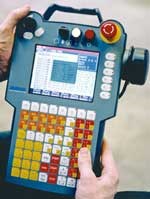
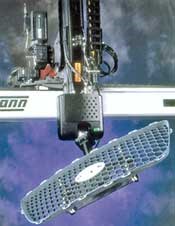
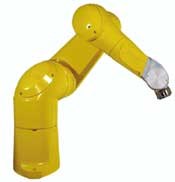









.png;maxWidth=300;quality=90)











